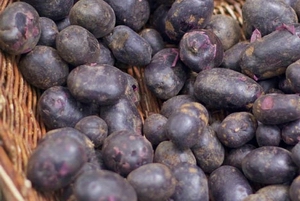 or may not have noticed a new potato in town at your local grocer or more likely at your local health food store. It is native to South America and is called the purple potato, named for its deep purple skin as well as the purple flesh within it. There are several types of the purple potato including the Purple Majesty, Purple Viking and Purple Peruvian varieties.
or may not have noticed a new potato in town at your local grocer or more likely at your local health food store. It is native to South America and is called the purple potato, named for its deep purple skin as well as the purple flesh within it. There are several types of the purple potato including the Purple Majesty, Purple Viking and Purple Peruvian varieties.Purple potatoes are rich in antioxidant phytochemicals
The rule of thumb with fruits and vegetables is that the deeper and richer the color, the more nutritious the content tends to be. The purple potato is no exception to this rule. It is rich in the antioxidant that is characteristic of deeply colored blue or purple produce called anthocyanin.
This compound is from the powerful flavonoid family of antioxidants and is found in other nutritional powerhouse foods such as blueberries and pomegranates. It is most well-known for its immunity boosting and cancer fighting properties.
Further, this deeply pigmented antioxidant has shown great promise in protecting the integrity and structure of DNA and encouraging the production of cytokines which are vital to proper immune response. It also shows impressive anti-inflammatory properties, helps to protect the health and integrity of the capillaries and strengthen membranes, and may have a role in regulating estrogenic activity which can help lower risk of hormone-related disease.
Study shows purple potatoes aid in lowering blood pressure
A small study that was presented at the American Chemical Society National Meeting in Denver in 2012 found that eating these potatoes lowered the blood pressure of the subjects who consumed them compared to non-consumers. This is likely due to their therapeutic effect on the capillaries and blood vessels as mentioned earlier and the purple potato's high concentration of another phytochemical called chlorogenic acid which has been linked to lower blood pressure in mice.
Potatoes are typically associated with weight gain and by some as a "forbidden food" due to their high starch content. So to many it was a surprising outcome that consuming six to eight small purple potatoes per day not only lowered the blood pressure of the participants but also caused no weight gain at all.
Is there a flavor or texture compromise for the increased nutrition?
So you may be thinking since the purple potato has so much more nutrition than the standard white potato that there must be some flavor or texture compromise? It turns out that the purple potato tastes remarkably similar to standard white-fleshed potatoes.
It has a slightly nutty flavor and a creamier texture when compared to traditional potatoes. This makes it ideal for baking, mashing, pan frying and doing pretty much anything else that you might do with a standard potato. It can be delicious when blended with various herbs and garlic and makes a great mashed potato dish since it has a creamier texture when cooked.
As with other varieties of potatoes, try to keep the skin on when cooking. Keeping the skin on when cooking helps seal the nutrients and moisture in the potato. In addition, the skin of any potato is rich in fiber and may also contain additional vitamins and minerals. The skin of the purple potato is rich in vitamin C and contains a lot of the polyphenols and potassium that makes it so beneficial.





